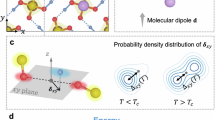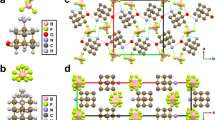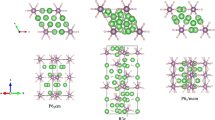Abstract
THE prototypical ferroelectric compound KH2PO4 contains hydro-gen bonds that exhibit interesting properties. The proton lies in one of two equivalent positions between oxygen atoms of two PO4tetrahedra. Below the ferroelectric transition temperature Tc there exists ordering of the protons in one of these two minima. A large increase in Tc is observed when the proton is substituted by a deuteron. Here we report results which show that in both KH2PO4and its deuterated form KD2PO4 at room temperature (that is, above Tc), the hydrogen-bond length decreases initially with increasing pressure, but then an abrupt and pronounced elongation occurs at a critical pressure Pc, corresponding to 2.7 and 4.2 GPa for KH2PO4 and KD2PO4 respectively. At Pc, the bond lengths are nearly equal to those predicted if the proton (deuteron) were to be located in a single minimum at the midpoint of the two oxygens. The P–O bond lengths in the PO4 tetrahedra also begin to decrease above Pc. These observations suggest that there may be a fairly complex interrelation of the various bond lengths involved in the ferroelectric transition, and reveal a hitherto unsus-pected property of the hydrogen bond.
This is a preview of subscription content, access via your institution
Access options
Subscribe to this journal
Receive 51 print issues and online access
$199.00 per year
only $3.90 per issue
Buy this article
- Purchase on SpringerLink
- Instant access to full article PDF
Prices may be subject to local taxes which are calculated during checkout
Similar content being viewed by others
References
Nelmes, R. J., Tun, Z. & Kuhs, W. F. Ferroelectrics 71, 125–141 (1987).
Samara, G. A. Phys. Rev. Lett. 27, 103–106 (1971).
Samara, G. A. Ferroelectrics 7, 221–224 (1974).
Meyer, G. M., Nelmes, R. J. & Vettier, C. J. Phys. C13, 4035–4051 (1980).
Nelmes, R. J. & Tibballs, J. E. Ferroelectrics 39, 1041–1044 (1981).
Tibballs, J. E., Nelmes, R. J. & Mclntyre, G. J. J. Phys. C15, 37–58 (1982).
Tibballs, J. E. & Nelmes, R. J. J. Phys. C15, L849–L853 (1982).
Nelmes, R. J. Ferroelectrics 71, 87–124 (1987).
Ichikawa, M., Morita, K. & Yamada, N. Phys. Rev. B36, 874–876 (1987).
Merril, L. & Bassett, W. A. Rev. Sci. Instrum. 45, 290–294 (1974).
International Tables for X-Ray Crystallography Vol. 4 (Kynoch, Birmingham, 1974).
Matsushita, E. & Matsubara, T. Prog. Theor. Phys. 67, 1–19 (1982).
Coulson, C. A. Valence 2nd edn. 349 (Oxford University Press, London, 1961).
Author information
Authors and Affiliations
Rights and permissions
About this article
Cite this article
Endo, S., Chino, T., Tsuboi, S. et al. Pressure-induced transition of the hydrogen bond in the ferroelectric compounds KH2P04 and KD2P04. Nature 340, 452–455 (1989). https://doi.org/10.1038/340452a0
Received:
Accepted:
Issue date:
DOI: https://doi.org/10.1038/340452a0



